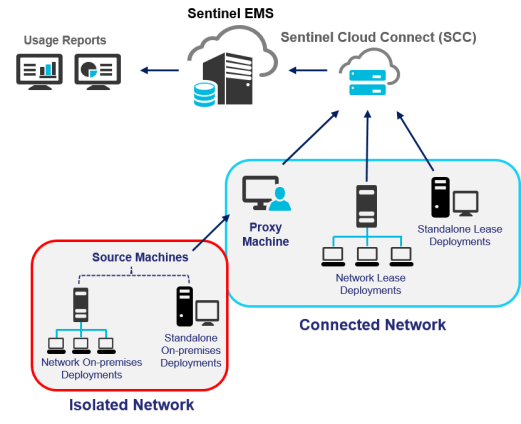Role of SCP Under On-premises Deployment Mode
Under on-premises deployment, the role of SCP is to facilitate the transfer of usage data from the isolated network (depicted below) to Sentinel Cloud Connect (SCC).

The machines running the Sentinel RMS-licensed applications (standalone systems or clients of the RMS License Manager) may operate in on-premises isolated networks. Their offline usage data continues to be collected on the standalone system itself or the RMS License Manager host—both referred to as the source machines. The system administrator on the customer site can carry out transmission of usage data to facilitate reports generation for such isolated users. To achieve this, the system administrator needs to follow the procedure described below.
The system administrator needs to copy the offline usage data of the source machines into a storage device. The data from the storage device is then copied to another machine that has internet connection, known as the proxy machine. When the Sentinel Cloud Plug-in (SCP) on the proxy machine starts in offline mode, the offline usage data is uploaded to the SCL (Sentinel Cloud Licensing) server. This uploaded usage data is used to generate reports in Sentinel EMS. On the proxy machine, corresponding to the uploaded usage data, acknowledgment data is created. The system administrator further needs to copy the acknowledgment data back to the source machines to ensure that the uploaded usage data is not accumulated over a period.
In on-premises network mode, RMS License Manager maintains usage information from all client machines running in a network and records them in usage log files. In on-premises standalone mode, the Sentinel RMS client libraries maintain the usage log files.
To learn about the workflow of usage data collection in on-premises mode, refer to Usage Data Collection.